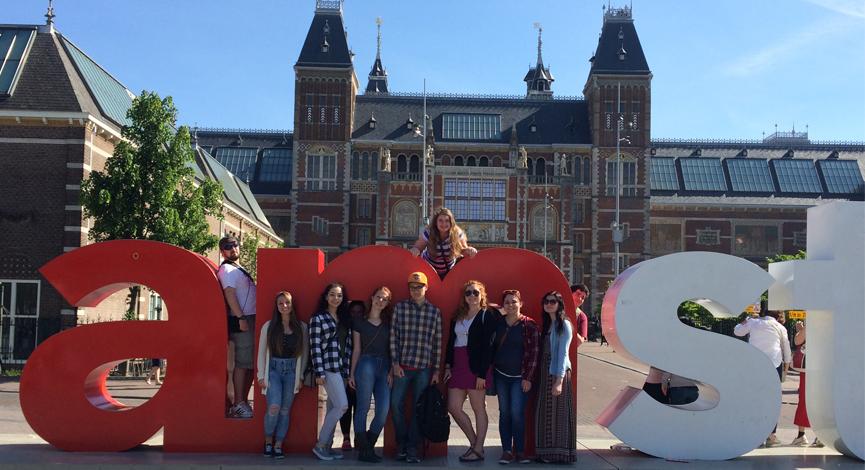
There is a strong need for an understanding of science when dealing with the preservation and conservation of art. Eleven students and two chemistry professors, Dr. Nate Beres and Dr. Aaron Roerdink, explored the connection during a 10-day excursion to Amsterdam in May.
To prepare for the trip, the students enrolled in the two-credit-hour chemistry course, “The Science of Art.” This course was open to all students regardless of major. The class spent the spring semester learning the science component of art – the chemistry of paint, chemical reactions on marble and metals, for example – and then headed off to explore some of Europe’s finest museums.
“One of the questions we asked at the beginning was, ‘What is art?’” Beres said. “Some of them really broadened their horizons.”
Senior Rachel Raimondo, a biology (pre-med) major and chemistry minor who admits she thought about attending art school, was captivated by the combination of the fields of art and chemistry. The trip was a perfect adventure for her. “I had never thought about art in terms of chemistry,” she said. “Chemistry is beautiful in itself, but in combination with art, it’s intriguing and beautiful.”
While in the Netherlands, the group toured conservation studios at the University of Amsterdam, Redivivus Studios and the Kröller-Müller Museum as well as the Royal Delft Porcelain Factory. “It was interesting for our students to see that science can lead you in a completely different area that they had never thought about,” Roerdink said.
Along the way, they got up close and personal with the works of some world-class artists such as Vincent Van Gogh and Isaac Israels.
The students were within mere inches of some very famous paintings. At the Kröller-Müller Museum, where three van Gogh paintings were in their final stages of restoration, they were given the opportunity to view them under a microscope.
“Seeing Van Gogh’s paintings in person took my breath away,” Raimondo said. “I was extremely nervous. I didn’t want to sneeze on it.” Junior biochemistry major Kiera Malone agreed. “When they opened the doors and we saw three paintings on the table, I was shaking. It was such a surreal experience. How many people can say that they got to look at a van Gogh that closely?”
Malone, who has studied abroad in Spain and Scotland, gained experience applying scientific knowledge to other fields. While on an internship in California following the Amsterdam trip, she visited the La Brea Tar Pits and wondered about the solvents being used to safely remove tar from the fossils. Seeing major pieces of art in person helped her in her quest to find a good balance between art and science.
The experience also broadened her world view. “I definitely think about the van Gogh today still and his internal struggle. It’s helped me find beauty in the world and how people see and translate it into art. How important is that in our world, especially today?”
To prepare for the trip, the two professors traveled to Amsterdam a year earlier to make connections at museums and travel sites. That opened the doors for some private tours for the Heidelberg group.
The students also had the opportunity to do some sight-seeing while in the Netherlands, taking a canal cruise, using train transportation and visiting such places as The Hague and a Salvador Dali exhibit in Rotterdam. Other highlights were a visit to the former concentration camp in Vught and a tour of Anne Frank’s hiding house. Both were somber experiences.
Beres and Roerdink are planning to lead another trip to Amsterdam next spring. They note that the trip is not just for science majors. If this sounds like a trip for you, now is the time to start planning. The first step will be signing up for CHM 108 in the spring.
If you’d like more information about next year’s trip, feel free to contact Beres at nberes [at] heidelberg.edu (nberes[at]heidelberg[dot]edu) or Roerdink at aroerdin [at] heidelberg.edu (aroerdin[at]heidelberg[dot]edu).